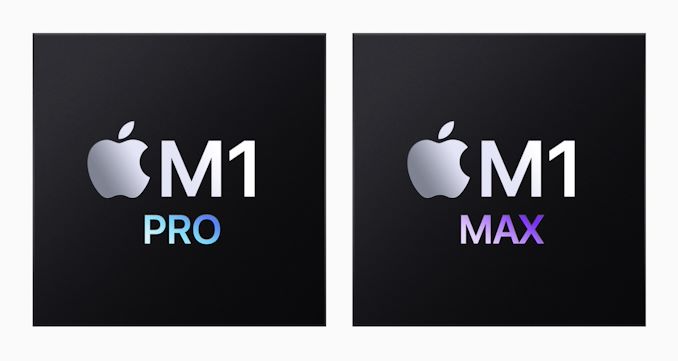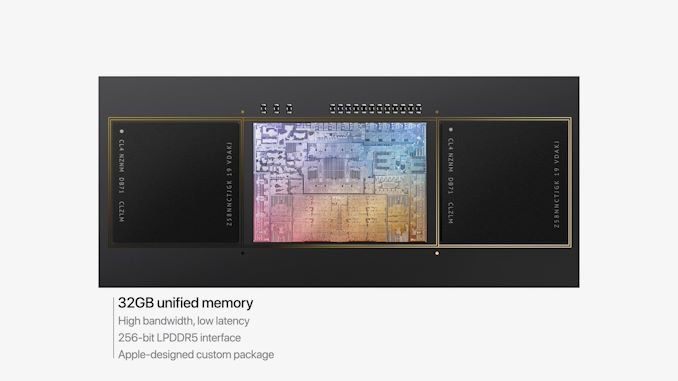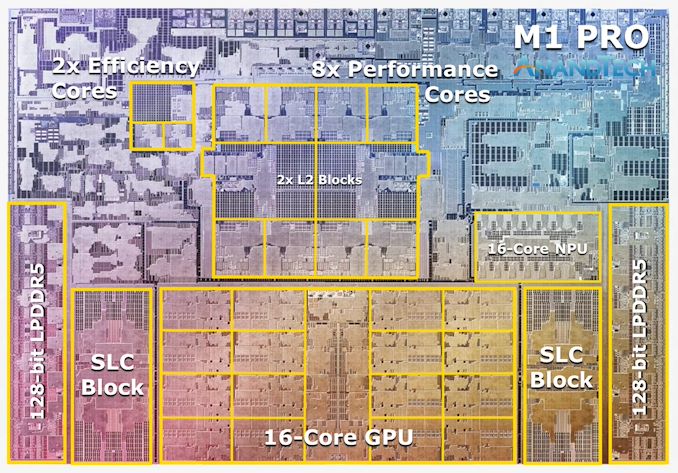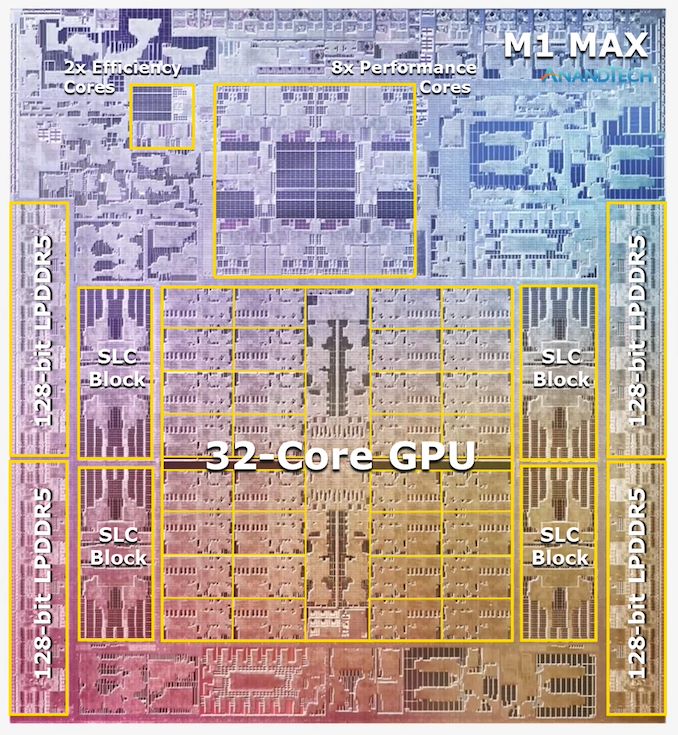Apple's M1 Pro, M1 Max SoCs Investigated: New Performance and Efficiency Heights
by Andrei Frumusanu on October 25, 2021 9:00 AM EST- Posted in
- Laptops
- Apple
- MacBook
- Apple M1 Pro
- Apple M1 Max

Last week, Apple had unveiled their new generation MacBook Pro laptop series, a new range of flagship devices that bring with them significant updates to the company’s professional and power-user oriented user-base. The new devices particularly differentiate themselves in that they’re now powered by two new additional entries in Apple’s own silicon line-up, the M1 Pro and the M1 Max. We’ve covered the initial reveal in last week’s overview article of the two new chips, and today we’re getting the first glimpses of the performance we’re expected to see off the new silicon.
The M1 Pro: 10-core CPU, 16-core GPU, 33.7bn Transistors
Starting off with the M1 Pro, the smaller sibling of the two, the design appears to be a new implementation of the first generation M1 chip, but this time designed from the ground up to scale up larger and to more performance. The M1 Pro in our view is the more interesting of the two designs, as it offers mostly everything that power users will deem generationally important in terms of upgrades.
At the heart of the SoC we find a new 10-core CPU setup, in a 8+2 configuration, with there being 8 performance Firestorm cores and 2 efficiency Icestorm cores. We had indicated in our initial coverage that it appears that Apple’s new M1 Pro and Max chips is using a similar, if not the same generation CPU IP as on the M1, rather than updating things to the newer generation cores that are being used in the A15. We seemingly can confirm this, as we’re seeing no apparent changes in the cores compared to what we’ve discovered on the M1 chips.
The CPU cores clock up to 3228MHz peak, however vary in frequency depending on how many cores are active within a cluster, clocking down to 3132 at 2, and 3036 MHz at 3 and 4 cores active. I say “per cluster”, because the 8 performance cores in the M1 Pro and M1 Max are indeed consisting of two 4-core clusters, both with their own 12MB L2 caches, and each being able to clock their CPUs independently from each other, so it’s actually possible to have four active cores in one cluster at 3036MHz and one active core in the other cluster running at 3.23GHz.
The two E-cores in the system clock at up to 2064MHz, and as opposed to the M1, there’s only two of them this time around, however, Apple still gives them their full 4MB of L2 cache, same as on the M1 and A-derivative chips.
One large feature of both chips is their much-increased memory bandwidth and interfaces – the M1 Pro features 256-bit LPDDR5 memory at 6400MT/s speeds, corresponding to 204GB/s bandwidth. This is significantly higher than the M1 at 68GB/s, and also generally higher than competitor laptop platforms which still rely on 128-bit interfaces.
We’ve been able to identify the “SLC”, or system level cache as we call it, to be falling in at 24MB for the M1 Pro, and 48MB on the M1 Max, a bit smaller than what we initially speculated, but makes sense given the SRAM die area – representing a 50% increase over the per-block SLC on the M1.
The M1 Max: A 32-Core GPU Monstrosity at 57bn Transistors
Above the M1 Pro we have Apple’s second new M1 chip, the M1 Max. The M1 Max is essentially identical to the M1 Pro in terms of architecture and in many of its functional blocks – but what sets the Max apart is that Apple has equipped it with much larger GPU and media encode/decode complexes. Overall, Apple has doubled the number of GPU cores and media blocks, giving the M1 Max virtually twice the GPU and media performance.
The GPU and memory interfaces of the chip are by far the most differentiated aspects of the chip, instead of a 16-core GPU, Apple doubles things up to a 32-core unit. On the M1 Max which we tested for today, the GPU is running at up to 1296MHz - quite fast for what we consider mobile IP, but still significantly slower than what we’ve seen from the conventional PC and console space where GPUs now can run up to around 2.5GHz.
Apple also doubles up on the memory interfaces, using a whopping 512-bit wide LPDDR5 memory subsystem – unheard of in an SoC and even rare amongst historical discrete GPU designs. This gives the chip a massive 408GB/s of bandwidth – how this bandwidth is accessible to the various IP blocks on the chip is one of the things we’ll be investigating today.
The memory controller caches are at 48MB in this chip, allowing for theoretically amplified memory bandwidth for various SoC blocks as well as reducing off-chip DRAM traffic, thus also reducing power and energy usage of the chip.
Apple’s die shot of the M1 Max was a bit weird initially in that we weren’t sure if it actually represents physical reality – especially on the bottom part of the chip we had noted that there appears to be a doubled up NPU – something Apple doesn’t officially disclose. A doubled up media engine makes sense as that’s part of the features of the chip, however until we can get a third-party die shot to confirm that this is indeed how the chip looks like, we’ll refrain from speculating further in this regard.














493 Comments
View All Comments
zodiacfml - Monday, October 25, 2021 - link
are you a miner? memory bandwidth maxes at 400gb/s, basically 50-60mh/s at half the power consumption of a 5700xt or 3070. the m1-max is at least $3500 and no miner software yet though if it does mine could help the alleviate the huge cost.Nice piece of tech but I'd be happy with an M1 or M2 device.
vladx - Tuesday, October 26, 2021 - link
Yep I guess he didn't look at the memory bandwidth of RTX 3070 Mobile which comes in laptops 1/3 of the price of the cheapest M1 Max Macbook.zodiacfml - Tuesday, October 26, 2021 - link
yeah if one looks at mining alone but considering the efficiency, the integration/small size, display, aluminum chassis, etc... it is not much more expensive than a thin and light laptop with a mobile rtx 3080. i still believe the m1-max is equivalent to that card, only no x86 game is natively ported to the M1.vladx - Tuesday, October 26, 2021 - link
A miner buys these laptops because they are more available than a desktop GPU, they'll buy a dozen of them solely for mining and nothing else so they don't give a crap how thin or how much they would weight.ComputeGuru - Thursday, October 28, 2021 - link
The RTX 3070 in my Legion 5 Pro does 65MHs.Oxford Guy - Monday, October 25, 2021 - link
Several comments argue that Apple is making a good decision by exploiting casual mobile gaming and not 'AAA' gaming — as if those are mutually exclusive.While I don't know how much value there is in bribing companies to port to metal + M — is there anything other than preventing companies from doing it of their own volition? Here are some possible issues:
1. The cost/difficulty of implementing invasive complex DRM that's designed for Windows.
2. Apple's track record for breaking backward compatibility quickly, both with macOS internals (and, judging by that record, metal going forward specifically).
3. Perceived market share, not only in terms of capable M hardware but also in terms of its buyers demographic.
4. The concern that Apple might lock all software in macOS (possibly with exceptions for MS Office and Adobe) behind the same paywall it uses for iOS, thus requiring a heavy royalty chunk. How the Epic lawsuit goes...
5. How well will the hardware handle the very high sustained utilization of the GPU, in terms of noise and throttling? Will Apple throttle the laptops with a software update to preserve battery viability/life, as it did with the iPhone?
Oxford Guy - Monday, October 25, 2021 - link
Also,6. Will Apple choose to make a 'console' instead of pushing macOS gaming?
StuntFriar - Tuesday, October 26, 2021 - link
1. Not an issue. Existing cross-platform solutions exist to cater for different types of games.2. If you're maintaining your own game engine, then yes. Otherwise, licensed engines like UE4 and Unity sort most of the kinks out for you.
3. This - games just don't sell on the Mac. I've worked with a few publishers over the years, and Mac versions are never considered, even if the engine supports it.
4. This has never been a deterrent to publishers pushing games on consoles. Self-published Indie devs will complain because of lack of funds.
5. Not an issue. We scale the quality on games based on the ability of the hardware. The same game can appear on Switch and PS4, but with some compromises on the former.
6. Unlikely. It's a highly competitive market and Apple has to offer something that the big 3 don't have. They have no unique IP and would have to spend a boatload of money to get enough exclusive content to even be a viable secondary or even tertiary platform for people who own multiple consoles (let alone primary).
Oxford Guy - Tuesday, October 26, 2021 - link
'Not an issue. Existing cross-platform solutions exist to cater for different types of games.'You're claiming that all the popular DRM is native in macOS? That's news to me!
'It's a highly competitive market and Apple has to offer something that the big 3 don't have.'
How about 'It's a highly-competitive market and Apple has to offer something that the big 2 don't have' and 'It's a highly-competitive market and Apple has to offer something that the big player doesn't have'.
Claiming that three walled gardens is the limit needs to be supported with hard evidence. Let's see your data.
powerslave65 - Monday, October 25, 2021 - link
For the work the MXPro and Max are designed for they will no doubt deliver and that would be work, not pounding redbull bleary-eyed with video games for days losing an entire sound frequency patch of hearing to the howling fans of some jacked up PC. If you haven’t gotten there yet, video games are for children. Building things and making art is what one does when you grow up. Apple is clear headed about the difference and thankfully doesn’t give 2 f’s of thought about what a child wants from a professional laptop.